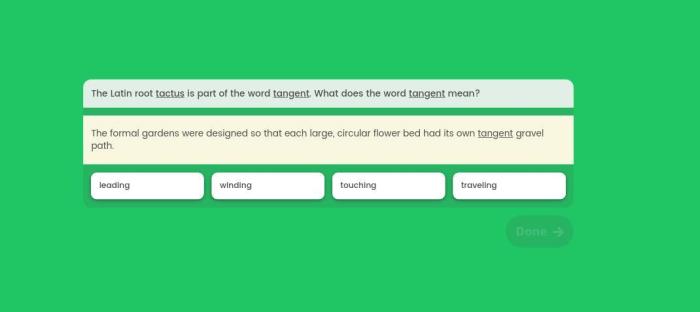The latin root tactus is part of the word tangent – The Latin root “tactus” is part of the word “tangent,” and it contributes to the word’s meaning in a significant way. In this article, we will explore the historical origins, semantic analysis, and cultural applications of “tactus” to gain a deeper understanding of its role in the English language.
The Latin root “tactus” means “to touch” or “to handle.” It is derived from the Proto-Indo-European root -tag-, which also means “to touch.” This root is found in many words in English and other Indo-European languages, such as “tactile,” “contact,” and “tactful.”
Historical Origins of the Latin Root “tactus”

The Latin root “tactus” originates from the Proto-Indo-European root “*teg-,” meaning “to touch.” In ancient Roman times, “tactus” emerged as a significant root, giving rise to numerous words related to the sense of touch.
Examples of Ancient Roman Words Derived from “Tactus”
- Tangere: To touch, to handle
- Tactilis: Pertaining to the sense of touch
- Tactus: The sense of touch, a feeling
Over time, “tactus” evolved in the Latin language, expanding its semantic range beyond the physical sensation of touch to encompass more abstract concepts.
Semantic Analysis of “Tactus” and “Tangent”

In English, “tactus” has given rise to the word “tangent,” which has both literal and figurative meanings.
Definition of “Tactus” and “Tangent”
- Tactus: The sense of touch, a feeling
- Tangent: A straight line that touches a circle or curve at only one point
While the literal meaning of “tangent” relates to the physical contact of a line with a curve, its figurative meaning extends to describe something that is only marginally or indirectly related to a main topic.
Semantic Relationship Between “Tactus” and “Tangent”
The semantic connection between “tactus” and “tangent” lies in the notion of “touching.” In geometry, a tangent line touches a circle or curve at a single point, similar to how the sense of touch allows us to perceive the surface of objects.
Use of “Tactus” in Scientific Terminology: The Latin Root Tactus Is Part Of The Word Tangent
The Latin root “tactus” plays a significant role in scientific terminology, particularly in fields related to the senses and perception.
Examples of Scientific Terms Incorporating “Tactus”
- Tactile perception: The ability to perceive touch
- Tactile stimulation: The act of stimulating the sense of touch
- Tactile feedback: Information conveyed through the sense of touch
These terms demonstrate the importance of “tactus” in conveying specific concepts and ideas in science, particularly those related to the sensory experience of touch.
Cultural and Literary Applications of “Tactus”
Beyond its scientific usage, “tactus” and its derivatives have found applications in cultural and literary contexts.
Metaphorical and Symbolic Meanings Associated with “Tactus”
- Tactile memory: A memory associated with a specific touch experience
- Tactile language: A form of communication using touch
- Tactile intimacy: Physical closeness and affection expressed through touch
In literature, “tactus” and its derivatives evoke sensory experiences and convey emotions, contributing to the richness and depth of literary works.
Comparative Analysis of “Tactus” in Different Languages
The Latin root “tactus” has cognates in various languages, each with its own semantic range.
Cognates of “Tactus” in Different Languages
- English: Tangent, touch, tactile
- French: Toucher, tactile, tangible
- Spanish: Tocar, tacto, tangible
While the core meaning of “tactus” related to touch remains consistent across languages, its semantic range and nuances may vary, reflecting cultural and historical influences.
Pedagogical Applications of “Tactus”

The Latin root “tactus” can be a valuable tool for language learning and vocabulary development.
Benefits of Using “Tactus” as a Pedagogical Tool, The latin root tactus is part of the word tangent
- Enhanced vocabulary development: Learning words derived from “tactus” expands students’ vocabulary.
- Improved etymology understanding: Studying “tactus” helps students understand the origins and evolution of words.
- Cognitive stimulation: Exploring the semantic range of “tactus” stimulates critical thinking and analytical skills.
Incorporating “tactus” into teaching plans can provide students with a deeper understanding of language and its historical roots.
Key Questions Answered
What is the meaning of the Latin root “tactus”?
The Latin root “tactus” means “to touch” or “to handle.”
What is the relationship between “tactus” and “tangent”?
The root “tactus” contributes to the meaning of “tangent” by indicating that the line or plane is touching another line or plane.
What are some examples of words that incorporate the Latin root “tactus”?
Some examples of words that incorporate the Latin root “tactus” include “tactile,” “contact,” “tactful,” and “intangible.”